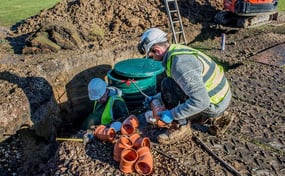We’re on LinkedIn!
Connect with WCS Environmental Engineering Safe Efficient Compliance

Most properties located in rural areas are not connected to mains drainage, requiring the land owner to find an alternative method for the removal of their sewage. This was the case for the owner of one such renovation project in the beautiful Hampshire countryside. The project saw the conversion of a barn and outbuilding into both holiday and long-term rental accommodation, alongside a picturesque thatched cottage.
The owner of the property had to first make a decision as to which sewage treatment plant they would like to install. A local installer to the site, Independent Drainage in Dorset, recommended a Diamond DMS3 wastewater treatment plant, based on the owners needs and site requirements. They suggested the Diamond because:
*subject to correct installation, consistent influent conditions and regular plant maintenance as per the manufacturers’ instructions.
The installation of a Diamond sewage treatment plant is simple. In this instance, it took less than three days in total with a small team required, providing very little disruption to the lives of the inhabitants. Unusually, the tank installation was designated to below a concrete courtyard rather than in a garden.
Dameon Brunn from Independent Drainage recalls, “Usually, we would connect the pipework beneath a grassy area, yet due to pre-existing pipework, this wasn’t possible. This made little difference to the installation time however, with the tank in the ground in a matter of hours. The connection of the pipework was carried out later than expected due to the delay of the British weather, which of course can never be helped!”
To create minimal visual impact, the top level was concreted over to restore the courtyard to its original appearance, with access to the plant still possible via a flush lid to the landscape.
With nutrient neutrality requirements being enforced at off-mains properties in areas of England, homeowners need to ...
Why managing variable loads matters If you have an off mains wastewater treatment system operating at a hospitality, ...
Trade effluents are liquid waste streams discharged into public sewers from businesses and industrial processes. Their ...
Connect with WCS Environmental Engineering Safe Efficient Compliance
WCS Group is a trading name for WCS Environmental Ltd, registered in England and Wales (Number 02184649) at 20 Grosvenor Place, London, SW1X 7HN. Head Office – 17 Wheatstone Court, Waterwells Business Park, Gloucester, GL2 2AQ. WCS Group is a Marlowe Critical Services Company owned by Marlowe plc. 2025© WCS Environmental Ltd.